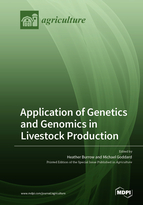Application of Genetics and Genomics in Livestock Production
A special issue of Agriculture (ISSN 2077-0472). This special issue belongs to the section "Farm Animal Production".
Deadline for manuscript submissions: closed (15 December 2022) | Viewed by 35457
Special Issue Editors
Interests: livestock genetic improvement; technology adoption and measurable industry impact; developing country applications
Special Issue Information
Dear Colleagues,
The delivery of genome sequences for most livestock species over the past 10–15 years has generated the potential to revolutionise livestock production globally, by providing farmers with the ability to match individual animals to rapidly changing climates, production systems and markets. Initially, technologies such as marker-assisted selection, functional genomics, gene expression, transcriptomics, proteomics and metabolomics were hailed as technologies with the greatest promise of delivering on that potential. To date, however, their potential for the delivery of practical solutions for livestock farmers is still to be realised, though they do provide supportive evidence of value to other approaches. Gene editing using tools such as CRISPR-Cas9 also show strong promise, but face regulatory hurdles before practical applications can be delivered for use by farmers. The technology that has had the greatest impact to date is genomic selection. This year marks 20 years since genomic selection was developed by Meuwissen, Hayes and Goddard (Genetics, 2001, 157: 1819-1829) and to date, genomic selection has been successfully applied in livestock, plants and even human health applications. However, genomic selection also faces ongoing limitations around lack of essential phenotypes, particularly for expensive or difficult-to-measure traits and possibly the need for faster/greater computational capacity. It is therefore timely to examine the impact of genomic technologies generally, and to identify successes and limitations that need to be overcome in order to achieve practical applications for livestock producers in future. This Special Issue therefore invites submissions addressing any of the “-omics” approaches (including phenomics) with the aim of summarising the successes, failures, limitations and ongoing challenges to deliver technologies that can be directly applied by livestock producers in both developed and developing countries.
Prof. Dr. Heather Burrow
Prof. Dr. Michael Goddard
Guest Editors
Manuscript Submission Information
Manuscripts should be submitted online at www.mdpi.com by registering and logging in to this website. Once you are registered, click here to go to the submission form. Manuscripts can be submitted until the deadline. All submissions that pass pre-check are peer-reviewed. Accepted papers will be published continuously in the journal (as soon as accepted) and will be listed together on the special issue website. Research articles, review articles as well as short communications are invited. For planned papers, a title and short abstract (about 100 words) can be sent to the Editorial Office for announcement on this website.
Submitted manuscripts should not have been published previously, nor be under consideration for publication elsewhere (except conference proceedings papers). All manuscripts are thoroughly refereed through a single-blind peer-review process. A guide for authors and other relevant information for submission of manuscripts is available on the Instructions for Authors page. Agriculture is an international peer-reviewed open access monthly journal published by MDPI.
Please visit the Instructions for Authors page before submitting a manuscript. The Article Processing Charge (APC) for publication in this open access journal is 2600 CHF (Swiss Francs). Submitted papers should be well formatted and use good English. Authors may use MDPI's English editing service prior to publication or during author revisions.
Keywords
- genomics
- phenomics
- gene expression
- gene editing
- customised applications for livestock producers
- ongoing limitations and challenges






